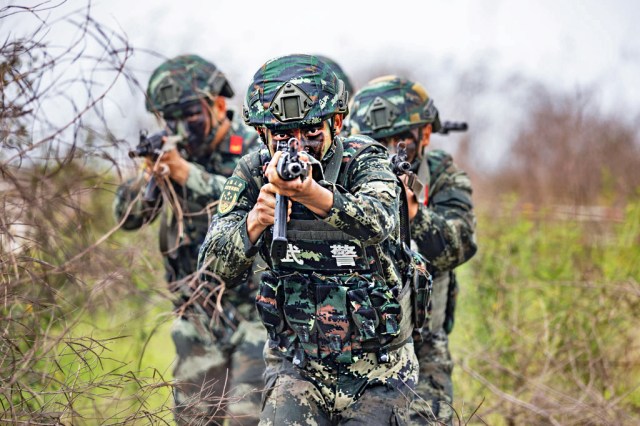Credit: Costfoto/Barcroft Media via Getty Images)

We’ve been lucky, for the last 70 or so years, to live through an essentially unprecedented period of world peace. It doesn’t necessarily feel like that, because there are always enough small wars and conflicts to fill 24-hour news channels – but there have been no direct conflicts between major powers since the Korean War of 1950-1953.
Since then, while there have been proxy wars (notably Vietnam) and local conflicts, no big, powerful countries have gone to war with one another. But there are still tensions, and if you were betting on a war between two great powers now, China and the US would again be the most likely.
The Korean peninsula is probably not where you’d bet on it starting, though. Instead, you might look to Taiwan, the self-governing island off the south-east coast of China. Just this week, a Chinese magazine published a video showing a simulation of a ballistic missile attack on Taiwan, disabling its defences ahead of an invasion. A week before, China sent 28 warplanes, including nuclear-capable bombers, into the air defence zone around Taiwan. At the same time, the Chinese leader Xi Jinping gave a speech promising to “utterly defeat any attempt toward ‘Taiwan independence’.”
The US is an ally of Taiwan’s; it would be expected to defend it, should China attempt to invade. But just as in Korea, two-thirds of a century ago, the question is: would it? And will China invade?
Recently, a group of anonymous superforecasters have tried to answer that question, and shared their work with me. They previously had a go at forecasting the outcomes of the rise of various Covid variants; now, they are interested in whether we ought to worry about Chinese aggression over Taiwan.
Most people are rubbish at actual, falsifiable forecasts. If you ask questions like “Will there be a conflict between China and Taiwan in which at least 100 people are killed before 2026?” or “Will the US defend Taiwan in the event of a conflict between Taiwan and China?”, and ask them to give percentage likelihoods of each eventuality (60%, 20%, 99%), then most people do no better than random guessing. But some people do a bit better, and superforecasters do exceptionally well.
My six forecasters who were considering what would happen with Taiwan were asking several questions, but the key one is probably the one I mentioned above: how likely is it that we will see a conflict between China and Taiwan in which at least 100 people are killed?
The first thing they do is to look at base rates. This is also known as taking the “outside view” on a problem, as opposed to the “inside view”. In a classic example: you’re at a wedding and you’re asked whether the marriage will be a lifelong one. If you look at the couple and think “they look very much in love” and base your answer on that, then you’re taking the inside view.
If, instead, you look at how many marriages in general end in divorce – about 40%, in the UK – and start from there, you’re using the outside view. You then use the inside view to adjust from there: if you know that the couple are well-suited to each other, you adjust your estimate up; if you think they’re not, you might adjust it down.
Regarding Taiwan, one wrote: “An elementary application of base rate thinking means that we have to put the probability of China going for Taiwan within the next five years at below 50 percent.” Since 1949, when the nationalist government was defeated in the Chinese civil war and its leaders fled to Taiwan, mainland China has never invaded the island. If the odds of an invasion in any given five-year period were above 50%, then the chance of making it to 70 years without one would be about one in 16,000.
But, then, they take inside-view considerations into account. For instance: China is catching up on the US in terms of military might. It “is serious about taking control of Taiwan”, which it sees as a threat, and is making more aggressive noises.
Taiwan itself is very badly defended and the defence it does have is ill-suited to the task (its military has “pursued a suicidal procurement strategy of expensive boutique US kit that will be no use in the crisis, like fighter jets that will be killed on the ground by the opening Chinese missile barrage”). The US military is aimed at fighting the War on Terror, not defending overseas territories against invasion. US public opinion might not support shedding blood over defending Taiwan.
On the other hand: a war would be a huge risk for China; “every Chinese leader has an incentive to leave such a risky endeavour to his successor,” another forecaster writes. In the short term, the balance of power is still with the Americans, and China can afford to be patient and wait until the middle of the century. The forecasters use facts like these to adjust their initial base-rate estimate.
The six forecasters estimate the likelihood of a significant China-Taiwan conflict at between 8% and 23% in the next five years, with a median estimate of 14%. That doesn’t sound all that bad, but it’s worth adding something.
If we’ve learnt anything from Covid, it should be that preparing for the most likely outcome is not enough. The odds of a global pandemic in any given year is probably only about 1%. But if one happens, it turns out, it’s really bad, and it would have been worth investing a significant amount of resources to avoid or mitigate it. One of the superforecasters told me that “a 14% chance of a proper conflict by 2026 is quite a big deal. If someone says there’s a 10% chance of a really bad outcome, the expected value [the impact multiplied by the probability] is still really bad.” So you might not think a particular bad outcome is very likely, but if it’s bad enough, then you ought to prepare for it anyway.
In the case of Covid, it’s understandable that the UK government didn’t foresee in February that a global pandemic was coming in March. Lots of people were saying it was, others were saying it wasn’t. But they should have foreseen that a global pandemic was highly plausible, that there was a non-trivial chance of complete disaster, and that quite drastic early steps to prevent it would have been justified.
And a Chinese invasion of Taiwan has the potential to be really bad. The superforecasters put together some conditional forecasts as well – that is, predictions of the form “How likely is event X if event Y happens?” So, for instance, if there is a conflict between China and Taiwan, how likely is the US to come to Taiwan’s defence, and how likely would China be to preemptively attack US forces?
The median estimate for how likely the US is to come to Taiwan’s aid if there were an invasion is 83%. So we are talking about a very high probability that a Chinese attack on Taiwan would lead to armed conflict between the world’s two superpowers. They also think it’s about 75% likely that the US would try to sink Chinese invasion ships, and say it’s reasonably likely that China would preemptively attack the US forces in the region if they did attack.
What might the knock-on effects be, if the world’s largest economies end up in a shooting war? Well: the US imports about $470 billion’s worth of goods from China a year. The superforecasters’ median estimate is that that would drop by 20%, or, roughly speaking, $100 billion. That’s the equivalent of the entire economy of Ecuador or Kenya. It would mean a huge blow to the world economy and probably push millions of people back into poverty. Huge US firms such as Nike or Apple would most probably stop manufacturing goods in China, again undoing decades of economic growth that has driven the rise of the Chinese middle class.
And what’s more, it’s very far from obvious that the US would win. If a war were to break out over Taiwan before 2026, the median estimate is that there’s a 57% chance of Chinese victory; if the war were to break out between 2031 and 2035, when China has had another decade to build up its military relative to the US, the estimate is 66%. “Once committed, China would need to prevail in order to save face and not have their government topple,” writes one. “I don’t believe China will start a hopeless war, so the likelihood of winning is over 50% if they start it, says another.
I asked the forecaster I spoke to if they’d talked about how likely it would be that a US-China conflict might escalate to a full-scale war or even nuclear war, and they hadn’t; they may readdress the question in future.
The Korean War started because great powers misjudged other powers’ willingness to defend allies and honour their treaty obligations: China and North Korea didn’t think the US would defend South Korea; the US didn’t think China would enter the war directly if the 8th Army crossed the 38th Parallel. It could easily happen again.
And the experience of that war shows that even a limited conflict between two great powers can be terrible – millions dead, years wasted, a country devastated for decades. Taiwan probably won’t spark a US-China war in the next five years, but it might, and if it does it would be a disaster.










Join the discussion
Join like minded readers that support our journalism by becoming a paid subscriber
To join the discussion in the comments, become a paid subscriber.
Join like minded readers that support our journalism, read unlimited articles and enjoy other subscriber-only benefits.
Subscribe